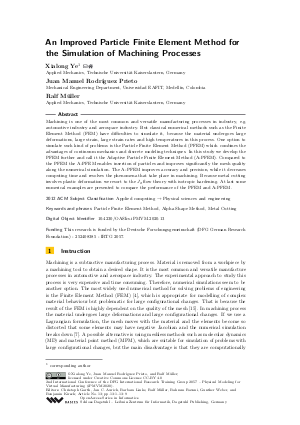An Improved Particle Finite Element Method for the Simulation of Machining Processes
Authors Xialong Ye, Juan Manuel Rodríguez Prieto, Ralf Müller
-
Part of:
Volume:
2nd International Conference of the DFG International Research Training Group 2057 – Physical Modeling for Virtual Manufacturing (iPMVM 2020)
Part of: Series: Open Access Series in Informatics (OASIcs)
Part of: Conference: International Conference on Physical Modeling for Virtual Manufacturing (iPMVM) - License:
 Creative Commons Attribution 4.0 International license
Creative Commons Attribution 4.0 International license
- Publication Date: 2021-04-27
File

PDF
OASIcs.iPMVM.2020.13.pdf
- Filesize: 1.91 MB
- 9 pages
Document Identifiers
Subject Classification
ACM Subject Classification
- Applied computing → Physical sciences and engineering
Keywords
- Particle Finite Element Method
- Alpha Shape Method
- Metal Cutting
Metrics
- Access Statistics
-
Total Accesses (updated on a weekly basis)
0Document
0Metadata
Abstract
Machining is one of the most common and versatile manufacturing processes in industry, e.g. automotive industry and aerospace industry. But classical numerical methods such as the Finite Element Method (FEM) have difficulties to simulate it, because the material undergoes large deformations, large strain, large strain rates and high temperatures in this process. One option to simulate such kind of problems is the Particle Finite Element Method (PFEM) which combines the advantages of continuum mechanics and discrete modeling techniques. In this study we develop the PFEM further and call it the Adaptive Particle Finite Element Method (A-PFEM). Compared to the PFEM the A-PFEM enables insertion of particles and improves significantly the mesh quality along the numerical simulation. The A-PFEM improves accuracy and precision, while it decreases computing time and resolves the phenomena that take place in machining. Because metal cutting involves plastic deformation we resort to the J₂ flow theory with isotropic hardening. At last some numerical examples are presented to compare the performance of the PFEM and A-PFEM.
Cite As Get BibTex
Xialong Ye, Juan Manuel Rodríguez Prieto, and Ralf Müller. An Improved Particle Finite Element Method for the Simulation of Machining Processes. In 2nd International Conference of the DFG International Research Training Group 2057 – Physical Modeling for Virtual Manufacturing (iPMVM 2020). Open Access Series in Informatics (OASIcs), Volume 89, pp. 13:1-13:9, Schloss Dagstuhl – Leibniz-Zentrum für Informatik (2021)
https://doi.org/10.4230/OASIcs.iPMVM.2020.13
BibTex
@InProceedings{ye_et_al:OASIcs.iPMVM.2020.13,
author = {Ye, Xialong and Prieto, Juan Manuel Rodr{\'\i}guez and M\"{u}ller, Ralf},
title = {{An Improved Particle Finite Element Method for the Simulation of Machining Processes}},
booktitle = {2nd International Conference of the DFG International Research Training Group 2057 – Physical Modeling for Virtual Manufacturing (iPMVM 2020)},
pages = {13:1--13:9},
series = {Open Access Series in Informatics (OASIcs)},
ISBN = {978-3-95977-183-2},
ISSN = {2190-6807},
year = {2021},
volume = {89},
editor = {Garth, Christoph and Aurich, Jan C. and Linke, Barbara and M\"{u}ller, Ralf and Ravani, Bahram and Weber, Gunther H. and Kirsch, Benjamin},
publisher = {Schloss Dagstuhl -- Leibniz-Zentrum f{\"u}r Informatik},
address = {Dagstuhl, Germany},
URL = {https://drops.dagstuhl.de/entities/document/10.4230/OASIcs.iPMVM.2020.13},
URN = {urn:nbn:de:0030-drops-137628},
doi = {10.4230/OASIcs.iPMVM.2020.13},
annote = {Keywords: Particle Finite Element Method, Alpha Shape Method, Metal Cutting}
}
Author Details
- Mechanical Engineering Department, Universidad EAFIT, Medellín, Colombia
Funding
This research is funded by the Deutsche Forschungsgemeinschaft (DFG German Research Foundation) - 252408385 - IRTG 2057.
References
-
H. K. Toenshoff B. Denkena. Spanen. Springer-Verlag, 2011.

-
K. Fischer. Introduction to alpha shapes. Department of Information and Computing Sciences,Faculty of Science, Utrecht University, 2000.

-
E. P. Mücke H. Edelsbrunner. Three-dimensional alpha shapes. ACM Transactions on Graphics, 13(1):43-72, 1994.

-
G. Holzapfel. Nonlinear Solid Mechanics. John Wiley & Sons, 2001.

-
S. R. Idelsohn, E. Oñate, F. Del Pin, and N. Calvo. The particle finite element method. an overview. International Journal of Computational Methods, 1(2):267-307, 2004.

-
T.J.R. Hughes J. C. Simo. Computational Inelasticity, volume 7. Springer Science & Business Media, 2006.

-
A. Svoboda J. M. Rodriguez, P. Jonsén. A particle finite element method for machining simulations. VII European Congress on Computational Methods in Applied Sciences and Engineering, Crete Island, Greece, 5–10 June 05/06/2016-10/06/2016, 1:539-553, 2016.

-
A. Svoboda J.M. Rodríguez, P. Jonsén. Simulation of metal cutting using the particle finite-element method and a physically based plasticity model. Computational Particle Mechanics, 4:35-51, 2017.

-
E. H. Lee. Elastic-plastic deformation at finite strains. Journal of Applied Mechanics, 36(1):1-6, 1969.

-
A. Frangi M. Cremonesi and U. Perego. A lagrangian finite element approach for the analysis of fluid–structure interaction problems. INTERNATIONAL JOURNAL FOR NUMERICAL METHODS IN ENGINEERING, 84:610-630, 2010.

-
R. Müller M. Sabel and C. Sator. Simulation of cutting processes by the particle finite element method. GAMM‐Mitteilungen, 40(1):51-70, 2017.

-
J. Oliver, J.C. Cante, R. Weyler, C. González, and J. Hernández. Particle finite element methods in solid mechanics problems. Computational plasticity, pages 87-103, 2007.

-
J. R. Shewchuk. Triangle: Engineering a 2d quality mesh generator and delaunay triangulator. Applied Computational Geometry: Towards Geometric Engineering, pages 203-222, 1996.

-
R. L. Taylor. Feap - a finite element analysis program: User manual. Department of Civil and Environmental Engineering, University of California, Berkley, 2009.

-
P. Wriggers. Nonlinear finite element methods. Springer Science & Business Media, 2008.

